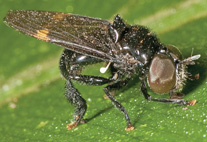Abstract
Several species of Neotropical Microdontinae (Diptera: Syrphidae) are mimics of stingless bees. Most of these species have previously been grouped in Ubristes Walker, 1852, with Carreramyia Doesburg, 1966, Hypselosyrphus Hull, 1937 and Stipomorpha Hull, 1945 treated as synonyms in recent literature. The species of the recently described genus Mermerizon Reemer, 2013 are also treated in the present paper. Recent evidence (Reemer and Ståhls 2013a, b) supports an independent origin for all of these taxa, which is why they are now treated as different genera. The present paper revises all specific taxa previously associated with these genera. A total number of 52 species is treated, 22 of which are described as new. These are divided among the genera as follows: Carreramyia (4 species, 2 new: C. megacera, C. tigrina), Ceratophya (5 species, 1 new: C. argentinensis), Hypselosyrphus (12 species, 6 new: H. helvus, H. marshalli, H. maurus, H. pingo, H. pseudorhoga, H. vexillipennis), Mermerizon (3 species, 2 new: M. mellosus, M. mesmerizus), Stipomorpha (25 species, 9 new: S. crematogastri, S. dichromata, S. elcopala, S. fallax, S. maculipennis, S. mendax, S. panamana, S. spuria, S. zophera), Ubristes (3 species, 2 new: U. ictericus, U. jaguarinus). Microdon scolopus Shannon, 1927, previously classified in Ubristes, was recently transferred to Ceratophya Wiedemann, 1824, which is why this genus is also treated in this paper. Ceratophya longicornis Wiedemann, 1824 is excluded from Ceratophya and treated as a species incertae sedis. Two other species are excluded, because they belong to other groups of Microdontinae not treated in the present paper: Microdon angulatus Hull, 1943 (now in Microdon subgenus Chymophila Macquart, 1834) and Ubristes chrysopygus Giglio-Tos, 1892 (now in Peradon Reemer, 2013). Three new synonyms are proposed: Microdon procteri Curran, 1941 syn. nov. = Microdon procedens Curran, 1941 syn. nov. = Ubristes flavitibia Walker, 1852; Microdon triangularis Curran, 1940 syn. nov. = Microdon lacteipennis Shannon, 1927. Two specific taxa previously considered as synonyms are rendered valid status: Ubristes litoralis Papavero, 1964 stat. rev. (placed in Stipomorpha) and Ubristes plaumanni Curran, 1940 stat. rev. (placed in Hypselosyrphus). One new name is introduced to replace a junior primary homonym: Hypselosyrphus amazonicus nom. nov. for Microdon scutellaris Shannon, 1927, preoccupied by Schummel (1842). Lectotypes are designated for Stipomorpha goettei (Shannon, 1927) and Stipomorpha lactipennis (Shannon, 1927). A key to the genus-groups and to the species is given. The genus Rhoga Walker, 1857 is included in the key to the genus-groups, but specific taxonomy is not worked out. The paper concludes with some considerations on mimicry as a possible drive for speciation, and on species of Stipomorpha visiting flowers.

